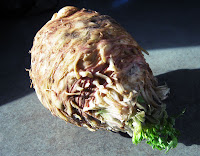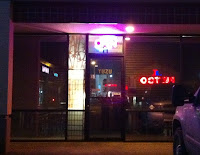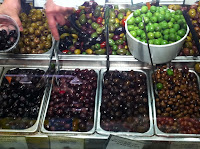Details: Ramsay's Dram (proposed), 6440 SW Capitol Hwy.
* * *
A new effort by the USDA, called Chefs Move to Schools, is working in conjunction with Michelle Obama's Let's Move campaign to get chefs involved with local students. The program now has a celebrity booster in Genoa's David Anderson (right). He spent last year working the students at Lewis Elementary School in Portland, giving hands-on lessons in taking produce picked in the garden and turning it into meals that any kid would love. Noting that some kids had never seen a pea pod on the vine, he said he loves to "watch those kids eyes light up." He and his brother, Chef Ray Anderson of Nuestra Cocina, are looking for other local chefs to sign up and adopt schools for the 2011-2012 school year.
Details: Chefs Move to Schools. Contact Sarah Medeiros by e-mail at Share Our Strength or call Tim Parsons, 503-866-1822 for information.
* * *
In Portland, pigs are as popular as backyard chickens, and seemingly as ubiquitous. While, unlike chickens, they're not (yet) allowed in back yards unless contained on a grill or spitted on a rotisserie over a bed of hot coals, pigs and their requisite parts are popping up like early spring daffodils on class lists all over the city:
- Whole Hog Butchery Class: Josh Graves and Eli Cairo teach the basics of breaking down and cutting, tying and processing a whole animal. Includes bag full of fresh, local pork. Sun., Mar. 6, 2pm; $125, 18 students, reservations required. Olympic Provisions, 107 SE Washington St. 503-954-3663.
- Basic Pig Butchery for Home Charcuterie: Gabriel Claycamp teaches how to butcher a pig to utilize all the muscle groups to produce cured pork specialties. Includes a share of meat and recipes. Sat., Mar. 12, 1-5 pm; $225, 12 students, reservations required. E-mail Portland Meat Collective to register.
- French Seam Butchery: Dominique Chapolard and Camas Davis teach how to transform a pig into premium French cuts using seam butchery, a traditional European method of breaking down animals according to their muscle seams. Includes charcuterie tasting and butchered meats. Wed., Mar. 16, 1-5 pm; $225, 12 students, reservations required. E-mail Portland Meat Collective to register.























































There lies most marvelous stuff
Treasures of Truffles
12:
Oh! Dew Drop Riches
Forested in your niches
Take me there again
13:
The foragers gaze
Only broken by smiles
In bountiful woods
14:
Black and white are tight
on all my favorite dishes,
so trufflicious!
15:
Dirt worm chance
My pig’s nose
Found it and an arrowhead.
16:
Truffle dance,
melt sensuously in
to the void I fear.
17:
It was our first time
You and I unearthed much more
Now we search as one
18:
How best to woo you?
Shaved lightly over pasta
Fragrant lumps of love
Photos above by Kathryn LaSusa Yeomans.